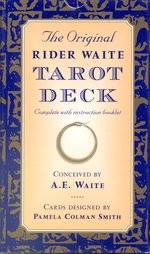The Original Rider Waite Tarot Deck
- Unit price
- / per
-
Author:WAITE A E / SMITH Pamela Colman
-
ISBN:9780712670579
-
Publication Date:July 2019
-
Edition:1
-
Pages:80
-
Binding:Cards
-
Publisher:Rider and Co.
-
Country of Publication:USA


A Back Order button means that we don’t have the book in stock at our store. It may already be on order – or we can order it for you from a publisher or distributor at no additional cost.
As we source items from around the globe, a back-order can take anywhere from 5 days to several weeks to arrive, depending on the title.
To check how long this might take, you’re welcome to contact us and we can provide an ETA or any other information you need. We recommend checking the timeframe before committing to an online order.
The Original Rider Waite Tarot Deck
- Unit price
- / per
-
Author:WAITE A E / SMITH Pamela Colman
-
ISBN:9780712670579
-
Publication Date:July 2019
-
Edition:1
-
Pages:80
-
Binding:Cards
-
Publisher:Rider and Co.
-
Country of Publication:USA
Description
First issued in 1910, the Rider-Waite Tarot is almost certainly the most widely used tarot deck in the world. There are 78 cards, divided into the Major and Minor Arcanas, designed by Pamela Colman Smith in accordance with A. E Waite's instructions. An instructional booklet by A. E. Waite is included, explaining the meanings of the cards and how to use them for divination, with an introduction by Stuart R. Kaplan.
Adding product to your cart
You may also like
A Back Order button means that we don’t have the book in stock at our store. It may already be on order – or we can order it for you from a publisher or distributor at no additional cost.
As we source items from around the globe, a back-order can take anywhere from 5 days to several weeks to arrive, depending on the title.
To check how long this might take, you’re welcome to contact us and we can provide an ETA or any other information you need. We recommend checking the timeframe before committing to an online order.
You may also like
You may also like
-
First issued in 1910, the Rider-Waite Tarot is almost certainly the most widely used tarot deck in the world. There are 78 cards, divided into the Major and Minor Arcanas, designed by Pamela Colman Smith in accordance with A. E Waite's instructions. An instructional booklet by A. E. Waite is included, explaining the meanings of the cards and how to use them for divination, with an introduction by Stuart R. Kaplan.
-
-
Author: WAITE A E / SMITH Pamela ColmanISBN: 9780712670579Publication Date: July 2019Edition: 1Pages: 80Binding: CardsPublisher: Rider and Co.Country of Publication: USA
First issued in 1910, the Rider-Waite Tarot is almost certainly the most widely used tarot deck in the world. There are 78 cards, divided into the Major and Minor Arcanas, designed by Pamela Colman Smith in accordance with A. E Waite's instructions. An instructional booklet by A. E. Waite is included, explaining the meanings of the cards and how to use them for divination, with an introduction by Stuart R. Kaplan.
-
Author: WAITE A E / SMITH Pamela ColmanISBN: 9780712670579Publication Date: July 2019Edition: 1Pages: 80Binding: CardsPublisher: Rider and Co.Country of Publication: USA
-



